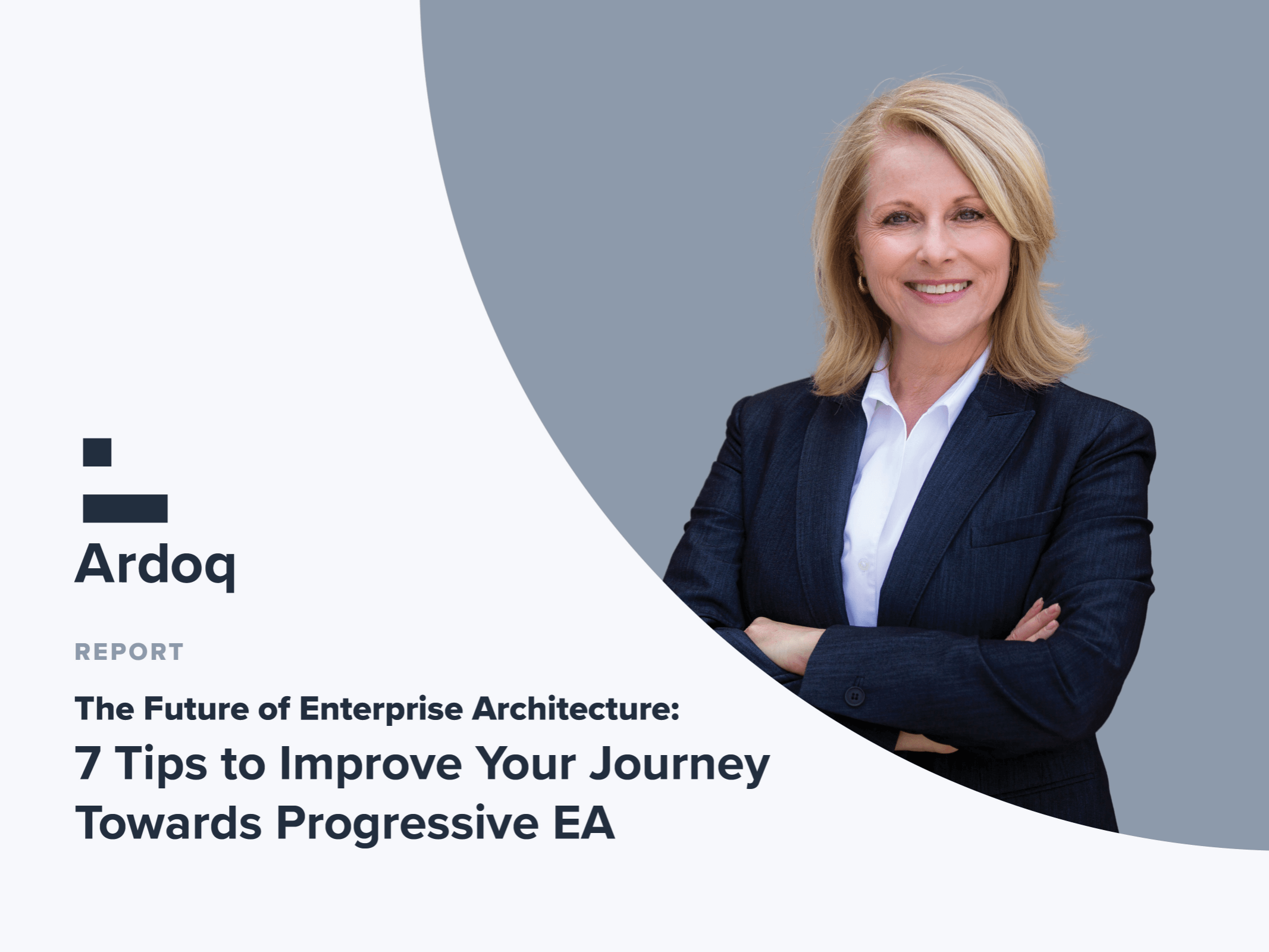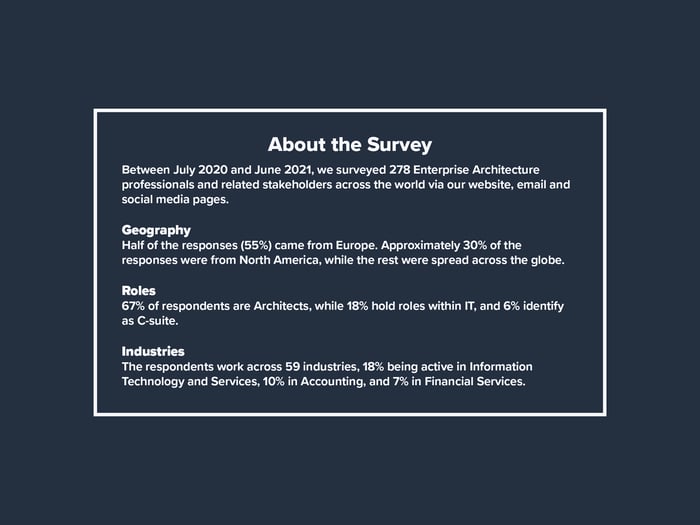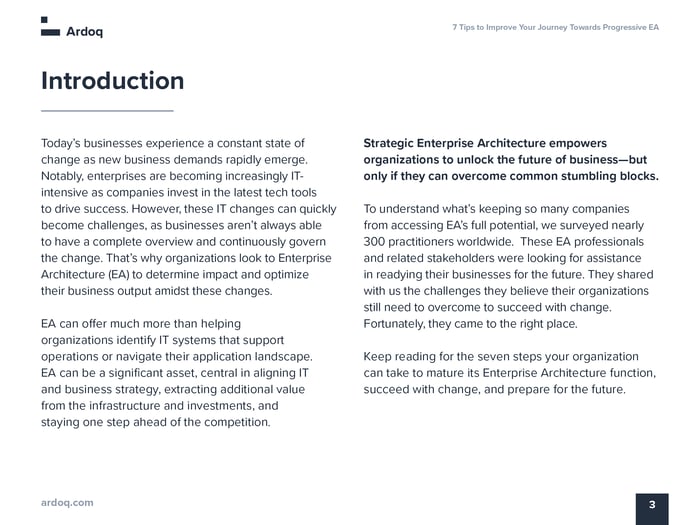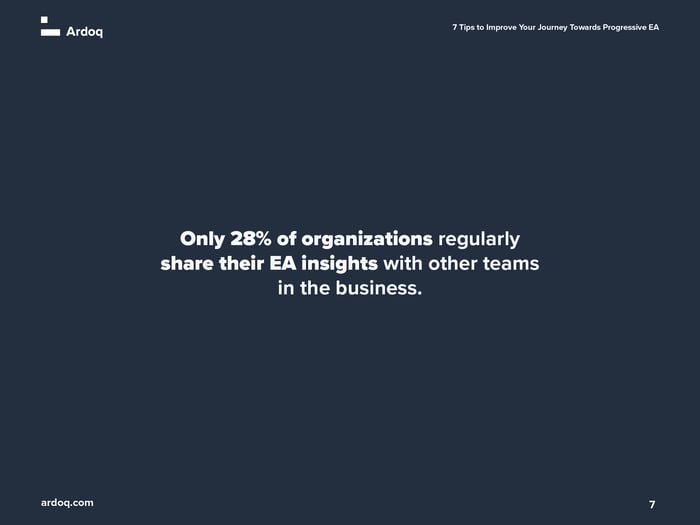The Future of Enterprise Architecture: 7 Tips to Improve Your Journey
Find out how CIOs, Enterprise Architects and IT professionals envision the future of EA.

Ardoq Is Trusted by Digitally Forward Companies Worldwide
Enterprise Architecture empowers organizations to unlock the future of business —but only if they are able to overcome common stumbling blocks.
Today’s businesses experience constant change as new demands rapidly emerge. In response, many organizations are turning to EA to help them determine impact and optimize their business output as they adjust —but few are leveraging Enterprise Architecture as effectively as they could be.
To understand what’s keeping so many companies from accessing EA’s full potential, we surveyed nearly 300 practitioners worldwide on the challenges they believe their organizations still need to overcome in their change processes. Their responses informed this report.
If you’re looking to level up your EA practice to arm your organization for the future, follow these seven steps today:
1. Meet Your Colleagues Where They Work to Get the Best Data
Enterprise architects (EAs) know they need a complete overview of their organization to understand how their role influences it, but relying on their own data collection process risks them zeroing in on their business segment instead of basing judgments on the organization as a system of interrelated departments.
Not only will collaborating with colleagues make the task of data collection more manageable for your team, but it will enable you to capture those nuances that don’t appear in a spreadsheet to achieve a more colorful picture of the organization.
2. Automate Insights to Easily Share With Every Stakeholder
Document sharing and understanding with those outside the EA team can be challenging to pull off. But boxing yourself in —whether intentional or not— compromises how much trust and responsibility stakeholders are willing to give you.
With an Enterprise Architecture platform that automatically generates an overview of progress in understandable terms for individuals across the organization, you’ll be able to show that you and your team know what you’re talking about.
3. Take Control of Your IT Portfolio
It isn’t easy to cohesively manage IT-intensive organizations —especially if you don’t own or have visibility into all the pieces.
Get your IT infrastructure in order through strategic Application Portfolio Management. With a centralized overview of every application and system in the IT portfolio, you’ll be able to catch risks before they become a major problem.
4. Add Business Context to Your Change Process
If change efforts don’t serve explicit, relevant purposes, they’ll create unnecessary disruption within the enterprise, taking time and resources away from other core business activities.
Proactively connecting with business leaders and stakeholders assists you in understanding their expectations and priorities while allowing you to devise strategies that map towards them.
5. Manage Change, Cost, and Risk as You Scale
Organizations need to maintain visibility into their infrastructure to control risk. Otherwise, they can’t plan and execute change successfully since they’re putting out fires from unmitigated variables.
Maintaining connected information about your IT and business environments offers visibility to help you identify risk factors proactively. With clear insights into the application experts within your ranks and where you need support, you can be confident that IT tools are being managed correctly.
6. Understand the Impact of Your Strategy and Projects Across the Whole Business
In the rush to digitally transform, it’s easy to get swept up in technology trends without considering how they can play a part in the business in the long term —but making decisions without business sync means those changes are less likely to deliver meaningful results.
Here’s where EAs have an opportunity to shine. Backed by your organizational data, you can influence the change prioritization process —and save your company from making poor investments.
7. Simulate and Compare Current and Future States At-Speed
If there’s one constant in business today, it’s that nothing stays the same for long. And yet, far too many organizations aren’t prepared to weather change swiftly and efficiently.
External factors —like a global pandemic or economic meltdown— can upend even the best laid plans, which is why you need to have a few roadmaps in your back pocket.
To enter the future with confidence, you first need to put Enterprise Architecture at the intersection of IT and business.
Odds are, some of your most trusted EA tactics are better left in the past. Time to change that. By coupling these new tricks with data-driven, future-forward EA tools, you’ll be able to not only overcome the challenges of today but excel amidst the opportunities of tomorrow.


